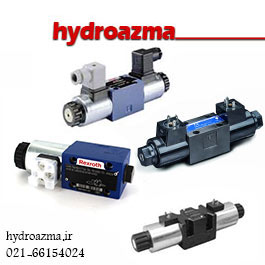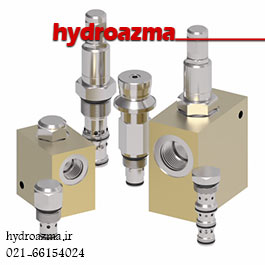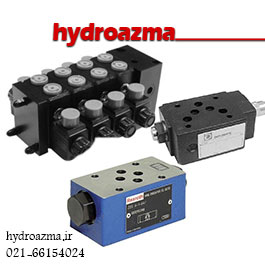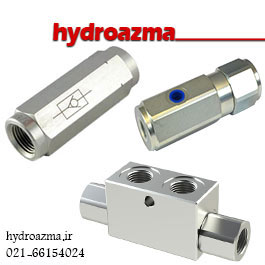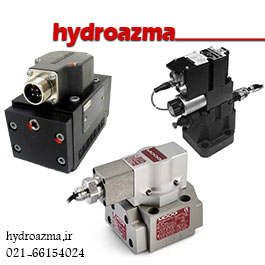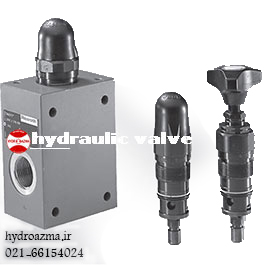
Hydraulic valves

Hydraulic valves
Hydraulic valves are used as one of the most important components of a hydraulic system in all hydraulic units and hydraulic circuits. This hydraulic control unit is called a set of hydraulic fluid direction control valves, hydraulic system pressure control and hydraulic system flow control. The performance of hydraulic valves in the system, the type of activation and deactivation of these valves, as well as the size of hydraulic valves, have become the reason for making a wide range of hydraulic valves. In this section of the hydraulic equipment store, there are various types of hydraulic fluid control valves.
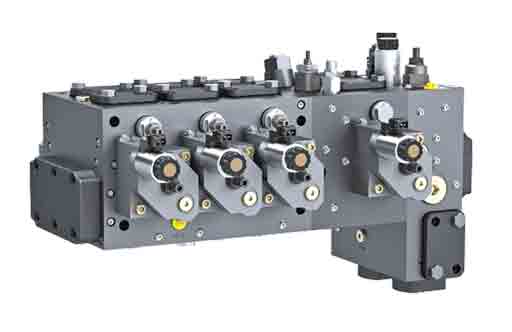
Types of hydraulic valves in terms of performance
- Direction control valves: they change the direction of fluid movement.
- Pressure control valves: they are also called relief valves and are responsible for controlling the pressure of the system.
- Variable flow or flow control valves: they have the task of controlling the flow rate of the system.
- Proportional hydraulic valves
- Servo hydraulic valves
- Modular hydraulic valves )
Types of hydraulic valves according to the type of actuation
- Manual actuation
- Solenoid actuation
- Mechanical or cam actuation
- Air actuation
Electric hydraulic valve is one of the most used type of hydraulic valve and these valves work by electric power. The flow rate of the hydraulic system is cut off, connected or adjusted with the help of a solenoid valve. Solenoid valves are divided into two categories: single spool hydraulic valve and double spool hydraulic valve, and the electric command is transmitted to the spool by a socket. Inside hydraulic solenoid valves, there is a part called a spool, which has two washers on its sides and There are two springs; With the help of electrical stimulation, the spool changes its state and this state change can lead to flow or interruption of flow.
Hydraulic solenoid valve has various models; All types of solenoid valve models are used in industries such as cement, steel, automotive and heavy industries.
Hydraulic direction control valves
The first category of hydraulic valve is hydraulic direction control valve. These valves are used to manage the direction of fluid flow and determine the path of fluid flow in the circuit. For example, they can determine the direction of movement of a cylinder or hydraulic motor. According to their functions, these valves are divided into one-way, two-way, multi-way, etc. The naming of direction control valves is done according to the number of positions and openings of the valve, and this naming is done in such a way that first the number Openings and then the number of positions are stated.
Hydraulic pressure control valves
Another type of hydraulic valve is hydraulic pressure control valve. This group of hydraulic valves protects the system against sudden pressure changes; Sudden changes occur due to several factors such as a decrease in the flow rate or an unwanted increase due to the opening and closing of the valve. Sudden changes in the system can cause instantaneous changes even up to 4 times the normal pressure in the system; Since increasing the pressure more than the specified limit can cause serious damage to the hydraulic valve; The need to use a pressure control valve is justified. In a hydraulic system, the output power depends on the pressure and fluid flow, so to achieve the desired goals when designing the circuit, the following must be determined:
- System pressure
- Geometric parameters and sizes of valves
- System flow rate
Use of pressure control hydraulic valves
- Simple safety valve: These valves are required to take care of pipelines and other hydraulic equipment against pressure increase.
- Combined safety valve: It is just like the simple safety valve, with the difference that It makes it possible to access the exact pressure level.
- Pressure reducing valve: They provide a reduced pressure at the system outlet regardless of the input pressure.
- Unloading valve: It discharges the flow from the positive displacement pumps to the tank at zero pressure when the hydraulic system is not under load, thus reducing power consumption and heat losses caused by fluid discharge through the safety valve at high pressure.
- Balancing valve: it creates resistance against the flow in one direction and allows it to flow in the other direction.
- Sequential valve: as the name suggests This milk is specific; It directs the flow in different directions and in a specific order.
- Pressure switch: these valves are sensitive to the decrease or increase of fluid pressure.
Variable flow or flow control hydraulic valves
Another category of hydraulic valve is hydraulic flow control valve. Flow control valves are used to adjust the speed of cylinders and hydraulic motors by changing their input or output flow rates. The main tool for this control is changing the level of flow in the bottleneck.
There are two main ways to classify flow control hydraulic valves:
- No pressure compensation system
The use of these valves is related to the situation where the system pressure is almost constant and we do not want to set the exact speed. The simplest type of these valves are flow restrictors, which are made by having a simple one-way valve throat.
- With pressure compensation system
These valves are automatically adjusted to pressure changes and always keep the pressure drop constant; In this way, the amount of current passing through them will remain constant.
How to choose a hydraulic valve
Choosing the correct hydraulic valve from among the products available in the market is one of the most efficient skills; Because this choice can be economical in addition to the direct effect on the efficiency of the hydraulic system. For the proper selection of a hydraulic valve, it is necessary to pay attention to a set of points so that the valve behaves according to the designed program. Some of these points are:
- Application of hydraulic valve in the system
As mentioned, valves can perform pressure control, flow control, and fluid flow direction control in the system; To choose, you should definitely pay attention to the use of milk in the system.
- The physical nature of the fluid passing through the hydraulic valve
The role of the fluid in hydraulic systems is to deliver the generated energy to the actuators (cylinders and hydraulic motors). Each hydraulic fluid has its own specific characteristics; The different properties of hydraulic fluids are for their different uses. According to the properties of oil-based hydraulic fluid, these fluids are more useful in the hydraulic system.
The fluid passing through the valves can be things like water, oil, gas, powder, various chemicals, etc. It should be noted that the fluid passing through the valves in this section is only mineral oil, and if another fluid is used, it can damage the valve, or if it is not seriously damaged, the valve will not work properly.
- Hydraulic valve size
Another important factor for choosing a hydraulic valve is their size. The size of the valves is very important for the proper functioning of the system; For example, if we choose a small valve size and the system pressure is high, the valve will not be able to pass the fluid completely, on the contrary, if we choose a larger valve size, then in addition to the additional cost imposed, we will see a significant pressure drop.
- Hydraulic valve steering in normal mode
It should be noted that the hydraulic valve before actuation may be available in two states, normally open and normally closed, while choosing them, it is important to pay attention to what state the valve was designed according to.
Finally, a set of these tips and more detailed information is defined as a hydraulic valve code, which makes ordering with this code much easier.
Another category of hydraulic valve is hydraulic flow control valve. Flow control valves are used to adjust the speed of cylinders and hydraulic motors by changing their input or output flow rates. The main tool for this control is changing the level of flow in the bottleneck.
There are two main ways to classify flow control hydraulic valves:
- No pressure compensation system
The use of these valves is related to the situation where the system pressure is almost constant and we do not want to set the exact speed. The simplest type of these valves are flow restrictors, which are made by having a simple one-way valve throat.
- With pressure compensation system
These valves are automatically adjusted to pressure changes and always keep the pressure drop constant; In this way, the amount of current passing through them will remain constant.
How to choose a hydraulic valve
Choosing the correct hydraulic valve from among the products available in the market is one of the most efficient skills; Because this choice can be economical in addition to the direct effect on the efficiency of the hydraulic system. For the proper selection of a hydraulic valve, it is necessary to pay attention to a set of points so that the valve behaves according to the designed program. Some of these points are:
- Application of hydraulic valve in the system
As mentioned, valves can perform pressure control, flow control, and fluid flow direction control in the system; To choose, you should definitely pay attention to the use of milk in the system.
- The physical nature of the fluid passing through the hydraulic valve
The role of the fluid in hydraulic systems is to deliver the generated energy to the actuators (cylinders and hydraulic motors). Each hydraulic fluid has its own specific characteristics; The different properties of hydraulic fluids are for their different uses. According to the properties of oil-based hydraulic fluid, these fluids are more useful in the hydraulic system.
The fluid passing through the valves can be things like water, oil, gas, powder, various chemicals, etc. It should be noted that the fluid passing through the valves in this section is only mineral oil, and if another fluid is used, it can damage the valve, or if it is not seriously damaged, the valve will not work properly.
- Hydraulic valve size
Another important factor for choosing a hydraulic valve is their size. The size of the valves is very important for the proper functioning of the system; For example, if we choose a small valve size and the system pressure is high, the valve will not be able to pass the fluid completely, on the contrary, if we choose a larger valve size, then in addition to the additional cost imposed, we will see a significant pressure drop.
- Hydraulic valve steering in normal mode
It should be noted that the hydraulic valve before actuation may be available in two states, normally open and normally closed, while choosing them, it is important to pay attention to what state the valve was designed according to.
Finally, a set of these tips and more detailed information is defined as a hydraulic valve code, which makes ordering with this code much easier.
